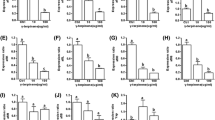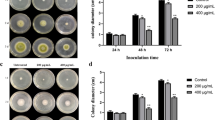Abstract
Cinnamaldehyde (CIN) is a promising natural preservative and generally recognized as safe for commodities as well as consumers. In this work, the antifungal effects of CIN on Aspergillus flavus were evaluated both in solid and in liquid culture conditions. Our results indicated that CIN effectively inhibited radial growth, spore production, mycelium formation, and aflatoxin B1 biosynthesis by A. flavus in a dose-dependent manner. At the concentration of 104 mg L−1, CIN exposure was able to completely inhibit fungal growth as well as aflatoxin B1 production. Furthermore, the inhibitory activities of CIN were closely connected with the treatment period and the tested fungal species. Compared with the control strains, CIN dose dependently changed the morphology and ultrastructure of mycelium in different degree. Especially, the reduction of hydrogen peroxide was considered to follow the destruction of mitochondrial. Meanwhile, CIN significantly cut the levels of lipid peroxidation and reduced glutathione. The activity of total superoxide dismutase was significantly inhibited after CIN treatment at the end of incubation, whereas the activities of catalase and glutathione peroxidase were opposite. These results indicated that the inhibitory effect of CIN could attribute to oxidative stress alleviation possibly induced by modifications of cellular structure as well as redox status.







Similar content being viewed by others
References
Bhatia R, Shreaz S, Khan N, Muralidhar S, Basir SF, Manzoor N, Khan LA (2012) Proton pumping ATPase mediated fungicidal activity of two essential oil components. J Basic Microbiol 52(5):504–512. doi:10.1002/jobm.201100272
Bradford MM (1976) Rapid and sensitive method for quantitation of microgram quantities of protein utilizing principle of protein-dye binding. Anal Biochem 72(1–2):248–254. doi:10.1006/abio.1976.9999
Bukvicki D, Stojkovic D, Sokovic M, Nikolic M, Vannini L, Montanari C, Marin PD (2015) Potential application of Micromeria dalmatica essential oil as a protective agent in a food system. LWT-Food Sci Technol 63(1):262–267. doi:10.1016/j.lwt.2015.03.053
Carmona L, Gandia M, Lopez-Garcia B, Marcos JF (2012) Sensitivity of Saccharomyces cerevisiae to the cell-penetrating antifungal peptide PAF26 correlates with endogenous nitric oxide (NO) production. Biochem Biophys Res Commun 417(1):56–61. doi:10.1016/j.bbrc.2011.11.050
Cheng S-S, Liu J-Y, Chang E-H, Chang S-T (2008) Antifungal activity of cinnamaldehyde and eugenol congeners against wood-rot fungi. Bioresour Technol 99(11):5145–5149. doi:10.1016/j.biortech.2007.09.013
Dimkic I, Beric T, Stevic T, Pavlovic S, Savikin K, Fira D, Stankovic S (2015) Additive and synergistic effects of Bacillus spp. isolates and essential oils on the control of phytopathogenic and saprophytic fungi from medicinal plants and marigold seeds. Biol Control 87:6–13. doi:10.1016/j.biocontrol.2015.04.011
Fanelli C, Fabbri AA, Finotti E, Passi S (1983) Stimulation of aflatoxin biosynthesis by lipophilic epoxides. J Gen Microbiol 129:1721–1723
Grintzalis K, Vernardis SI, Klapa MI, Georgiou CD (2014) Role of oxidative stress in sclerotial differentiation and aflatoxin B1 biosynthesis in Aspergillus flavus. Appl Environ Microbiol 80(18):5561–5571. doi:10.1128/aem.01282-14
Han C, Wang J, Li Y, Cui Y (2013) In vitro antimicrobial activity and effect on E. coli integrity of cinnamon essential oil and rhubarb ethanol extract. Food Sci Technol Res 19(6):1155–1163
Hartley RD, Okelly J, Nesbitt F (1963) Toxic metabolites of Aspergillus flavus. Nature 198(488):1056. doi:10.1038/1981056a0
Hayashi S, Yoshioka M, Matsui T, Kojima K, Kato M, Kanamaru K, Kobayashi T (2014) Control of reactive oxygen species (ROS) production through histidine kinases in Aspergillus nidulans under different growth conditions. FEBS Open Bio 4:90–95. doi:10.1016/j.fob.2014.01.003
Henze K, Martin W (2003) Evolutionary biology: essence of mitochondria. Nature 426(6963):127–128. doi:10.1038/426127a
Hissin PJ, Hilf R (1976) Fluorometric method for determination of oxidized and reduced glutathione in tissues. Anal Biochem 74(1):214–226. doi:10.1016/0003-2697(76)90326-2
Hua H, Xing F, Selvaraj JN, Wang Y, Zhao Y, Zhou L, Liu X, Liu Y (2014) Inhibitory effect of essential oils on Aspergillus ochraceus growth and ochratoxin A production. Plos One 9(9) doi:10.1371/journal.pone
Khan MSA, Ahmad I (2011) Antifungal activity of essential oils and their synergy with fluconazole against drug-resistant strains of Aspergillus fumigatus and Trichophyton rubrum. Appl Microbiol Biotehnol 90(3):1083–1094. doi:10.1007/s00253-011-3152-3
Kocevski D, Du M, Kan J, Jing C, Lacanin I, Pavlovic H (2013) Antifungal effect of Allium tuberosum, Cinnamomum cassia, and Pogostemon cablin essential oils and their components against population of Aspergillus species. J Food Sci 78(5):M731–M737. doi:10.1111/1750-3841.12118
Li WR, Shi QS, Ouyang YS, Chen YB, Duan SS (2013) Antifungal effects of citronella oil against Aspergillus niger ATCC 16404. Appl Microbiol Biotehnol 97(16):7483–7492. doi:10.1007/s00253-012-4460-y
Li H, Shen Q, Zhou W, Mo H, Pan D, Hu L (2015) Nanocapsular dispersion of cinnamaldehyde for enhanced inhibitory activity against aflatoxin production by Aspergillus flavus. Molecules 20(4):6022–6032. doi:10.3390/molecules20046022
Manso S, Cacho-Nerin F, Becerril R, Nerin C (2013) Combined analytical and microbiological tools to study the effect on Aspergillus flavus of cinnamon essential oil contained in food packaging. Food Control 30(2):370–378. doi:10.1016/j.foodcont.2012.07.018
Manso S, Pezo D, Gomez-Lus R, Nerin C (2014) Diminution of aflatoxin B1 production caused by an active packaging containing cinnamon essential oil. Food Control 45:101–108. doi:10.1016/j.foodcont.2014.04.031
Narasaiah KV, Sashidhar RB, Subramanyam C (2006) Biochemical analysis of oxidative stress in the production of aflatoxin and its precursor intermediates. Mycopathologia 162(3):179–189. doi:10.1007/s11046-006-0052-7
Ooi LSM, Li Y, Kam S-L, Wang H, Wong EYL, Ooi VEC (2006) Antimicrobial activities of cinnamon oil and cinnamaldehyde from the Chinese medicinal herb Cinnamomum cassia Blume. Am J Chin Med 34(3):511–522. doi:10.1142/s0192415x06004041
Otang WM, Grierson DS, Ndip RN (2011) The effect of the acetone extract of Arctotis arctotoides (Asteraceae) on the growth and ultrastructure of some opportunistic fungi associated with HIV/AIDS. Int J Mol Sci 12(12):9226–9235. doi:10.3390/ijms12129226
Park MJ, Gwak KS, Yang I, Kim KW, Jeung EB, Chang JW, Choi IG (2009) Effect of citral, eugenol, nerolidol and alpha-terpineol on the ultrastructural changes of Trichophyton mentagrophytes. Fitoterapia 80(5):290–296. doi:10.1016/j.fitote.2009.03.007
Patil RP, Nimbalkar MS, Jadhav UU, Dawkar VV, Govindwar SP (2010) Antiaflatoxigenic and antioxidant activity of an essential oil from Ageratum conyzoides L. J Sci Food Agric 90(4):608–614. doi:10.1002/jsfa.3857
Razzaghi-Abyaneh M, Shams-Ghahfarokhi M, Rezaee M-B, Jaimand K, Alinezhad S, Saberi R, Yoshinari T (2009) Chemical composition and antiaflatoxigenic activity of Carum carvi L., Thymus vulgaris and Citrus aurantifolia essential oils. Food Control 20(11):1018–1024 doi:10.1016/j.foodcont.2008.12.007
Razzaghi-Abyaneh M, Saberi R, Sharifan A, Rezaee M-B, Seifili R, Hosseini S-I, Shams-Ghahfarokhi M, Nikkhah M, Saberi I, Amani A (2013) Effects of Heracleum persicum ethyl acetate extract on the growth, hyphal ultrastructure and aflatoxin biosynthesis in Aspergillus parasiticus. Mycotoxin Res 29(4):261–269. doi:10.1007/s12550-013-0171-1
Reverberi M, Ricelli A, Zjalic S, Fabbri AA, Fanelli C (2010) Natural functions of mycotoxins and control of their biosynthesis in fungi. Appl Microbiol Biotechnol 87(3):899–911. doi:10.1007/s00253-010-2657-5
Reverberi M, Gazzetti K, Punelli F, Scarpari M, Zjalic S, Ricelli A, Fabbri AA, Fanelli C (2012) Aoyap1 regulates OTA synthesis by controlling cell redox balance in Aspergillus ochraceus. Appl Microbiol Biotechnol 95(5):1293–1304. doi:10.1007/s00253-012-3985-4
Tian J, Ban X, Zeng H, Huang B, He J, Wang Y (2011) In vitro and in vivo activity of essential oil from dill (Anethum graveolens L.) against fungal spoilage of cherry tomatoes. Food Control 22(12):1992–1999. doi:10.1016/j.foodcont.2011.05.018
Veal EA, Day AM, Morgan BA (2007) Hydrogen peroxide sensing and signaling. Mol Cell 26(1):1–14. doi:10.1016/j.molcel.2007.03.016
Visvalingam J, Holley RA (2012) Temperature-dependent effect of sublethal levels of cinnamaldehyde on viability and morphology of Escherichia coli. J Appl Microbiol 113(3):591–600. doi:10.1111/j.1365-2672.2012.05367.x
Wei DD, Zhou L, Selvaraj JN, Zhang CS, Xing FG, Zhao YJ, Wang Y, Liu Y (2014) Molecular characterization of atoxigenic Aspergillus flavus isolates collected in China. J Microbiol 52(7):559–565. doi:10.1007/s12275-014-3629-8
Wilhelm J, Fuksova H, Schwippelova Z, Vytasek R, Pichova A (2006) The effects of reactive oxygen and nitrogen species during yeast replicative ageing. Biofactors 27(1–4):185–193
Williams JH, Grubb JA, Davis JW, Wang J-S, Jolly PE, Ankrah N-A, Ellis WO, Afriyie-Gyawu E, Johnson NM, Robinson AG, Phillips TD (2010) HIV and hepatocellular and esophageal carcinomas related to consumption of mycotoxin-prone foods in sub-Saharan Africa. Am J Clin Nutr 92(1):154–160. doi:10.3945/ajcn.2009.28761
Wu T, Cheng D, He M, Pan S, Yao X, Xu X (2014) Antifungal action and inhibitory mechanism of polymethoxylated flavones from Citrus reticulata Blanco peel against Aspergillus niger. Food Control 35(1):354–359. doi:10.1016/j.foodcont.2013.07.027
Wunsch C, Mundt K, Li SM (2015) Targeted production of secondary metabolites by coexpression of non-ribosomal peptide synthetase and prenyltransferase genes in Aspergillus. Appl Microbiol Biotechnol 99(10):4213–4223. doi:10.1007/s00253-015-6490-8
Xing F, Hua H, Selvaraj JN, Zhao Y, Zhou L, Liu X, Liu Y (2014) Growth inhibition and morphological alterations of Fusarium verticillioides by cinnamon oil and cinnamaldehyde. Food Control 46:343–350. doi:10.1016/j.foodcont.2014.04.037
Acknowledgments
We gratefully acknowledge the financial support of the National Basic Research Program of China (973 program) (2013CB127805), Special Fund for Agro-scientific Research in the Public Interest (201203037), and National Program of China Basic Science and Technology Research (2013FY113400).
Author information
Authors and Affiliations
Corresponding authors
Ethics declarations
The authors confirm that principles of ethical and professional conduct have been followed in this research and in the preparation of this manuscript.
Conflict of interest
The authors do not have potential conflict of interest to disclose.
Additional information
Qi Sun and Bo Shang contributed equally to this work.
Rights and permissions
About this article
Cite this article
Sun, Q., Shang, B., Wang, L. et al. Cinnamaldehyde inhibits fungal growth and aflatoxin B1 biosynthesis by modulating the oxidative stress response of Aspergillus flavus . Appl Microbiol Biotechnol 100, 1355–1364 (2016). https://doi.org/10.1007/s00253-015-7159-z
Received:
Revised:
Accepted:
Published:
Issue Date:
DOI: https://doi.org/10.1007/s00253-015-7159-z




